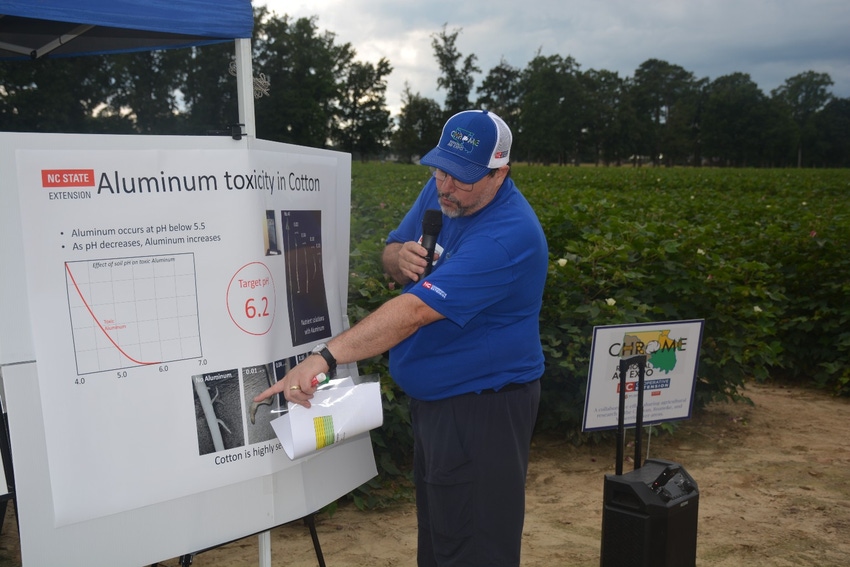
Aluminum is highly toxic for plants, particularly cotton, and every effort must be made to neutralize it by keeping soil pH at 6.2.
A challenge is when plant roots reach a soil layer with aluminum, the root growth just stops.
Speaking at the CHROME Ag Expo Aug. 16 at the Peanut Belt Research Station in Lewiston-Woodville, N.C, North Carolina State University Extension Soil Fertility Specialist Luke Gatiboni explained that aluminum occurs in soils with pH below 5.5, and as soil pH decreases, aluminum increases. That’s why it’s critical to maintain a soil pH of 6.2 in cotton.
“We don’t want to have aluminum at all in the soil. We need to keep pH in a good range by applying lime, avoiding the aluminum toxicity. We need to apply lime (calcium carbonate) which will react in the soil increasing the pH and neutralizing the aluminum. The lime reaction will neutralize acidity and will make a place for calcium to be held by the soil. Using lime properly will make the soil just right for root growth,” Gatiboni said.
However, Gatiboni noted lime has low mobility in the soil and its reaction will occur mainly in the soil layer where it was applied. “If lime was incorporated to an eight inch depth, aluminum may still be present in soil layers below the application zone. If lime was surface-applied in a no-till field, the lime reaction will be likely limited to the top four inch depth. In these situations, maybe gypsum can help promote root growth in deeper soil layers.”
Gatiboni emphasized that gypsum or land plaster is a different material than lime. Gypsum is calcium sulfate and cannot neutralize soil acidity, but it is more soluble and mobile in the soil, when compared with lime. As a consequence, gypsum will likely increase the calcium concentration in deeper soil layers. More calcium can alleviate the aluminum toxicity in those deeper soil layers.
“But there is a catch,” Gatiboni says. “Applying gypsum alone won’t reduce acidity in soils with low pH, so it is necessary to keep applying lime to increase your soil pH, and the gypsum would provide a complimentary effect in those soils with high acidity below the plow-zone.”
In dry years or drought-prone years, Gatiboni says applying gypsum will help you to have more calcium down in the soil profile, allowing for deeper roots to access more water in those dry years. By having more calcium lower in the soil profile in dry years, you can promote deeper root growth in the soil.
However, Gatiboni stressed applying gypsum alone won’t work because it will not neutralize acidity. The difference is lime will work in the layer where it is applied while gypsum will move down in the soil profile. Also, in years with adequate rainfall, gypsum shouldn’t be needed in cotton because the plants can get nutrients and water from the top layer of the soil. But during drought conditions or in dry years, more calcium down in the soil profile will mean deeper roots, allowing the plants to be more resilient and take up more water.
Gatiboni emphasized this strategy is especially important in no-till cotton, where lime is surface applied, and aluminum is likely to be present in deeper soil layers. For conventionally-tilled cotton, you can apply lime and mix it in with the soil, but you can’t do it in no-till fields.
Gatiboni is from southern Brazil. He returned to North Carolina State University in July 2019 after working 15 years at Santa Catarina State University in Brazil, researching and teaching on soil fertility. Gatiboni worked as a research scholar at North Carolina State in 2013-2014, studying systems to avoid water pollution, where he measured phosphorous thresholds for swine-manured soils.
Gatiboni noted that this system of applying both lime and gypsum has found success in his native Brazil because no-till is a very common practice in the tropical soils where aluminum toxicity can be a real problem and drought is an ongoing challenge.
This year, Gatiboni and a group of Extension agents from the CHROME (Chowan, Roanoke, and Meherrin River) region of eastern North Carolina began a five-year study to test if the strategy of applying both lime and gypsum in no-till cotton will work in the Tar Heel State.
In the trial, the researchers are applying gypsum alone, gypsum plus lime, lime alone, and a control. Gatiboni said the long-term, five-year approach is needed to determine if they can make the soil a better environment for the root system in no-till cotton.
About the Author(s)
You May Also Like






